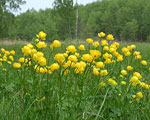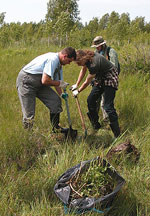|

Click to enlarge




|
PLANT SPECIES PROTECTION
Wigry National Park is characterized by a great richness of flora. Up till now, the occurrence of over 1,000 taxa (species, subspecies and varieties) of
vascular plants, including rare species constituting a part of unique plant assemblages, has been concluded. Up to 125 species of plants are listed on the
list of protected species, The Polish Red Book, the list of rare and endangered species or the Natura 2000 list of species, the protection of which is
important on the continental scale. The main direction of the protection of the Park’s flora is preserving the diversity of habitats and protecting them
against destruction.
Many species of rare plants occur on peat bogs. Therefore, the preservation of those habitats is an important aim of the Park’s protective activities. The
main threat for the peat bogs, notably low and transitional ones, is their overgrowing with shrubs and trees. The fragments of the peat bogs characterizing
with the occurrence of many rare species have been covered with active protection consisting in removing shrubs and maintaining their open area. Positive
effects of those measures can be visible in the permanent occurrence of the so-called plants with special needs.
In the area of the Park, a programme of introduction of species endangered with extinction in the Suwałki Region is carried out. It concerns particularly
the musk orchid — a species of orchid whose only site in the valley of the Rospuda River can be destroyed during road works. Some plants from the Rospuda
Valley have taken root in a new habitat in the WNP, thus giving hope for the preservation of this species.
Wigry National Park has also undertaken an attempt to save the hooded neottianthe. In recent years, this species has disappeared from many habitats in
Poland. Currently, it occurs only in two habitats. The former is in the area of the WNP, whereas the latter, more numerous habitat, is in the vicinity of
Augustów.
Some plants and their assemblages can be endangered with expansion of alien species, i.e. those capable of fast occupying new habitats and drawing the
native flora out of its habitats. Therefore, the Park actively eliminates certain alien species. It effectively managed to radically reduce the number of
giant hogweed – an expansive plant which is very dangerous, also for humans, on account of its scalding properties.
|